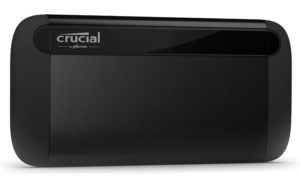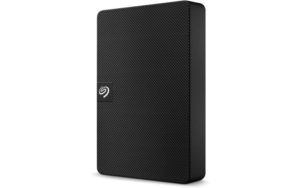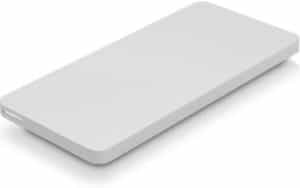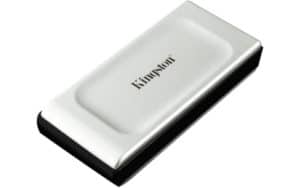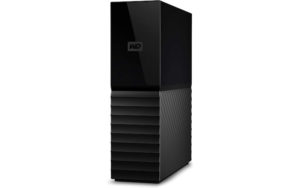Best External Hard Drives In 2023
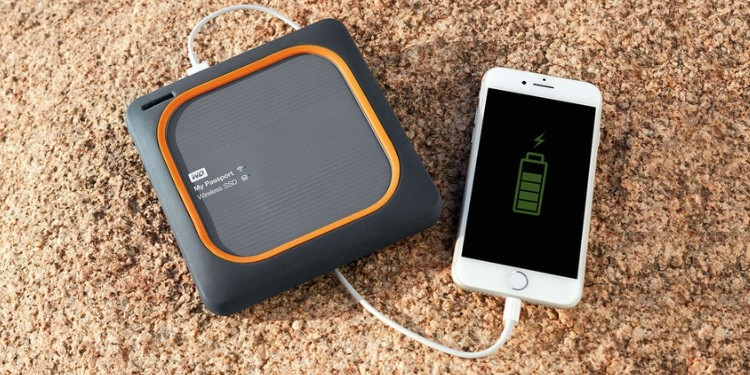
Table of Contents
The transition from USB 1.1 to USB 2.0 elevated that technology from a technology designed to connect mice and keyboards into something more useful. Suddenly there was enough bandwidth for external storage, even if the cap of around 60Mb/s was still short of what hard drives could achieve.
However, once USB 3.0 appeared, external drives operating at internal connection speeds became a reality. Then the market for these devices exploded. Being able to pocket substantial amounts of data and transport them to any system, had massive implications for those that need their information to follow them around.
However, USB isn’t the only technology available for external storage. Those who want the highest transfer rates opt instead for Thunderbolt interfaces.
With USB 3.0 and 3.2 Gen 2, the humble hard drive couldn’t keep pace. The decreasing cost of Flash NAND modules ushered in another transition from conventional hard drives to SSD storage.
These offer unprecedented performance levels, compact designs, and high levels of reliability. Plus they can withstand shock levels that would kill a conventional drive.
External drives are now faster, stronger, lighter, and cheaper than ever. Let’s look at the best products and why these specific models stand out from the crowd.
Products at a Glance
How we’ve picked the best External Hard Drives for 2023
Choosing external drives isn’t easy since there are many factors to consider.
A good design should offer a decent range of capacities, resilience, multiple connection options, the potential for drive encryption, high performance, and an affordable price.
Customer priorities have a significant role in promoting some designs above others. Some buyers will put security above everything else, while capacity or performance is king for others.
We’ve tried to equally gauge all of those factors, providing a more general scoring of a drive’s capabilities. However, some drives are inherently better in specific use cases, and we’ve pointed out when drives are especially fast, abuse resistant, or represent the best value.
Product Reviews
- Relatively cheap
- Robust
- Good performer
- Both USB-A and USB-C
- Limited capacities
- No hardware encryption
When Crucial first launched the X8, it had a significant impact on the market for external SSDs, as it ticked almost all the boxes for many customers.
The lightweight anodized aluminum unibody core is substantial. It comes with a cable that supports both USB-A and USB-C ports, can achieve 1,050MB/s, and the 1TB model isn’t much more than $100.
Achieving those headline speeds depends on having a USB 3.2 Gen 2 port on the host system. But that’s true of all external drives that quote close to those numbers.
What many like about the X8 is that it feels very substantial, and Crucial rates it to survive a 7.5ft drop onto a hard surface. It also offers a three-year warranty on the device.
There are a few weaknesses of the X8 when compared with other drives. Critically it doesn’t have the option for hardware encryption. You can still encrypt files on it with Windows Bitlocker To Go or macOS FileVault, but the lack of hardware-level encryption will be a dealbreaker for some.
The other is that the X8 only comes in 1TB or 2TB capacities. Those wanting 500GB or 4TB options must consider the newer Crucial X6 design – recently revamped to have a closer performance to the X8.
- Cheap
- Big Capacities
- Backup software included
- Affordable Rescue Plan
- Slow compared to SSD
For those prioritizing capacity over performance, solutions exist utilizing the larger capacity 2.5-inch hard drive mechanisms.
One of those exceptional value products is the new Seagate Expansion Portable series – along with the Expansion Desktop models, which use Seagate conventional hard drives repackaged in unassuming black enclosures.
Available in 1TB, 2TB, 4TB, and 5TB capacities, the Expansion Portable drives use 2.5-inch Seagate drives and connect to the host system using USB 3.0.
On the face of it, there isn’t much to separate this drive from the many that WD, Samsung, and Toshiba make. After all, USB-connected laptop drives aren’t revolutionary. But where this one stands out, and the reason it made our list, is the included utilities provided for this solution.
The software bundle comes pre-installed on the drive for both Windows and Mac, avoiding the need for an internet connection to get it loaded. Seagate Tools provides a buffet of functionality, including backups, drive mirroring, firmware updates, and even some diagnostic tools.
And, if you do have an issue that the tool can’t fix, Seagate offers a Rescue Plan for that. For $10 for two years cover, it will try to recover your data from an inaccessible drive.
These features, combined with the largest capacity drive costing a little over $100, make the Seagate Expansion Portable worthy of serious consideration.
- All metal construction
- Thunderbolt performance
- Super expensive
Other World Computing, Inc. (OWC) is a brand that addresses Apple Mac and high-end PC owners with an impressively engineered range of docking stations and peripherals.
Nothing OWC makes is inexpensive, and those operating within a tight budget won’t be gravitating to the OWC Envoy Pro FX Portable SSD soon.
Those that can afford one will discover an object with the physical gravitas of a metal ingot, that has been milled to provide a protective external home for an NVMe SSD. It’s small, light, yet highly robust.
However, the high cost of this drive isn’t down to the SSD inside or the precision-milled aluminum. It’s all about the electronics that connect this unit to the computer via a USB-C cable.
The only external drive in our line-up is USB 3.2 Gen 2 and Thunderbolt 3 compatible, enabling it to work on either interface seamlessly. And, if you do have a system with Thunderbolt ports, expect speeds above 2,000 MB per second for reading and writing.
By external drive standards, the Envoy Pro FX is about as good as it gets if you can afford it.
- 2,000MB/s read and write
- 5-year warranty
- Needs Gen 2x2 ports
- Limited capacities
Portable drives based on 2.5-inch laptop drives tend to be roughly the same size. Portable SSDs vary enormously, and the Kingston XS2000 is remarkably small.
It measures just 7 x 3.2 x 1.4 cm without its protective rubber sleeve, and weighs just 28.9 grams. So this is easily one of the smallest drives that utilize NVMe technology.
With the cover installed, it is still remarkably pocketable and nicely protected from arbitrary knocks and drops.
If there is a disappointment with this design, it’s the three relatively small sizes. Kingston offers 500GB, 1TB, and 2TB models, and 2TB is as big as the XS2000 gets.
However, what makes it different is that where most portable SSD makers limit performance to around 1,000MB/s, the XS2000 can use USB 3.2 Gen 2×2 ports, if you have them, and double that throughput.
On a standard USB 3.2 Gen 2 port, you will see 1,000MB/s reading and writing. Gen 2×2 ports aren’t currently that common though. It is possible to add them to a desktop system using a PCIe card if you have available slots.
What might put purchasers off is the high price of this design, as it costs at least 60% more than the same capacity Crucial X8.
- Great value
- Big capacities
- Works with most OSes
- HD level performance
- Not easily transportable
- Limited software included
No list of external hard drives would be complete without one from Western Digital. It’s this operation that made external drives so popular with its Passport series, and it makes a varied selection of them today.
The My Book series started with drives that resembled books, although this styling has now morphed into more of a nod than outright reference. Being upright standing avoids them taking large amounts of desk space and provides for better cooling.
Among the My Book products, the My Book Desktop series consists mostly of single 3.5-inch hard drives that attach to host systems using USB 3.0. Faster Gen 2 USB isn’t a prerequisite here since these don’t use SSD technology. That makes these drives compatible with most modern systems.
As that information infers, the My Book Desktop drives won’t win any performance competitions.
Where they fare better is the scale of drive space they offer and the excellent cost per GB of that space. Sizes start at 4TB, and increment in 2TB jumps right up to 18TB, missing out 10TB inexplicably.
Being built around a single drive mechanism, it offers no redundancy options. But WD makes the My Book Duo models for those that want storage that can cope with a single drive failing.
Other than the slow performance, the only significant downside to these is that they don’t come with any live backup utility. They do, though, they have a simple backup tool.
Things to consider
Probably the one thing that most customers of external drives don’t tend to consider is the performance of the machines that they’ll plug the drive into.
An external drive that can read and write at 1,000MB/s is fine, but only if the ports it is plugged into can handle those speeds and the internal drives of the machine are that quick.
Achieving those speeds requires USB 3.2 Gen 2 USB ports, as USB 3.2 gen 1 (aka USB 3.0) only offers around 500Mb/s of throughput. Equally, if the host machine is using SATA SSDs, these have a theoretical performance ceiling or around 500MB/s.
In both these instances investing in a fast external SSD will be pointless if the host system can’t exploit that speed.
Storage Mechanism: Mechanical or SSD?
First of all, you’ll need to decide whether you should go for the cheaper, slower mechanical hard drives or the more expensive, but faster solid state drives (SSD). Mechanical hard drives use mechanical components to store data while SSD drives store the data electronically.
So, are SSDs worth their much higher price point? Well, it depends on how you are using your storage drive.
For instance, SSDs are more physically resistant, so if you’re using your external drive on the go, where it is more likely to get bumped and dropped, then an SSD is the way to go. If it’s just stored in your desk most of the time though, then an HDD may be a better fit.
When it comes to speed, it’s more nuanced. If you’re using the external drive to store programs you actively use, like games, then an SSD will make load times faster. However, if you’re not using programs and you are only dropping a couple of hundred standard photos from your smartphone every month or two, then those massive read/write speeds will largely go to waste.
The more often you use your external drive and the larger those transfers are, the more useful an SSD will be. Otherwise, all that flash might just be for nothing.
Capacity
The capacity of an external storage drive is directly proportional to its price. If you are focusing only on storing some personal documents along with other small-size content, like family pictures, a 500-GB to 1-TB drive will fulfill your needs sufficiently. However, if you are intending to store other content, such as AAA games or Blu-Ray movies, then you should look for higher capacity drives.
An important thing to note here is that higher capacity HDDs have a higher failure rate, as they consist of more platters. However, SSDs are the opposite; the higher count of chips leads to a better life.
Transfer Rates
For the most part, transfer rates sit along a couple of important technological fault lines:
- HDDs. Most of mechanical hard drives usually have transfer rates around 100-150 MBps because of limitation of their mechanism
- SATA SSDs. These can be all over the place, but they are usually between 300 and 600 MBps
- NVMe SSDs. The latest NVMe drives have transfer rates up to several GBs per second
Extra Features (Protection, Connectivity and Warranty)
- Physical Protection. Many of the external drives now come with shock-proof designs and some of them are also dust and water-proof. This feature is certainly useful for people who want travel a lot. Some even receive IPX waterproof ratings, like the SanDisk Extreme.
- Connectivity. The ThunderBolt 3 can be helpful for people who work with Apple devices while the USB 3.1 Type-C port is getting more popular.
- Warranty. Some manufacturers offer a 1-year warranty for their external drives while others provide as high as a 3-year warranty along with data recovery features. Therefore, if you want to go for a reliable drive, make sure to get the one which offers a longer warranty.
Which brand is best for external hard drives?
The answer to that question was once easy because external drives used hard drive mechanisms. The brands that made these in-house were invariably the best.
These days with the advent of the SSD, it’s much harder to confirm where the NAND memory or controller inside an external drive comes from. As reviewers, we’ve also noticed a reticence to provide technical specifications for the drives, since makers often change these to make the build cheaper or use less expensive components.
Brands that make in-house NAND modules include Crucial (a subsidiary of Micron), Western Digital (SanDisk), Samsung and Kioxia (formerly Toshiba). While these make NAND, there are no guarantees that products branded by all of these include memory made by that company or even that the product is even manufactured by them.
Is SSD or HDD better for long-term storage?
An important question but extremely difficult to answer. How long any device with electronics inside will last is entirely dependent on how much it is used.
Therefore, if you write some data to a drive and then place it in a vault, it might last some considerable time and still be accessible. What complicates this more is that conventional hard drives have moving parts that will inevitably wear out. Most drives survive between three and five years with daily use.
SSDs built using NAND modules also wear out, as each time a NAND cell is rewritten takes a toll on that part. After repeated writes and reads, the cell will eventually wear out. To combat these limitations, modern drives use wear leveling code running on them that avoids the same cells taking all the damage.
The life of an SSD is calculated by taking its TBW (total bytes written) rating and dividing it by the amount written on average each day. If the TBW is 500TB, and each day 50GB of data is written, it will last approximately 10,000 days, or about 30 years, before the cells start to fail.
Overall, due to the lack of moving parts and having better resilience to being dropped, we’d argue that SSDs are better, but no existing storage technology is bullet-proof currently.
Our Verdict
The Crucial X8 is a 2020 design. But it still delivers an excellent combination of high speed, damage resistance, and affordability.
However, the recent appearance of the revamped X6 shows that Crucial has the technology to overhaul this design. And to deliver larger capacities and potentially even more outstanding performance under USB 4.0. If the designers could also offer the hardware encryption missing from the X8, it would be popular with many customers.
How long we must wait for a true successor to the X8, only Crucial knows, but it can’t be far away, we assume.
For now, the X8 is still an excellent choice for those that need quick external storage for a laptop; if they have USB 3.2 Gen 2 capable ports. For those that only have Gen 1, there are cheaper options.
For desktop computer users, the WD My Book series are hard to beat. Although these aren’t ideal for copying large files, and those wanting live backups will need to invest in an additional software solution that provides that.


